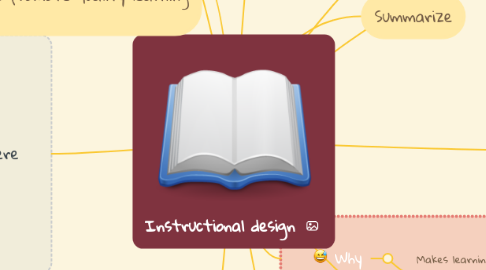
1. A systematic process, based on educational theories, on the development of instructional strategies, and specifications to promote quality learning experience
2. Who
2.1. Practitioner
2.1.1. Teachers
2.1.2. Lecturers
2.1.3. Tutors
2.1.4. Facilitators
2.1.5. Instructors
2.2. Gainer
2.2.1. Target groups
2.2.2. Learners
3. Where
3.1. At home
3.2. Lecture halls
3.3. Cyber cafe
3.4. Maker place
3.5. Smartphones
3.6. Any medium that has internet access
4. How
4.1. Addie
4.1.1. Analysis
4.1.1.1. Participant
4.1.1.2. Knowledge gaps
4.1.1.3. Purpose of programe
4.1.1.4. Media
4.1.1.5. Methodologies
4.1.1.6. Time flexibility
4.1.1.7. Possible
4.1.2. Design
4.1.2.1. Turn theory into action
4.1.2.2. Type of format usage
4.1.2.3. Methodology and strategy of training delivery
4.1.2.4. Insure the course is ready to be taken
4.1.3. Development
4.1.3.1. Medium
4.1.3.2. Polish the details
4.1.3.3. Run tests
4.1.3.4. Check on content
4.1.4. Implementation
4.1.4.1. Use Learning Management System
4.1.4.2. Distribute the materials
4.1.5. Evaluation
4.1.5.1. Put out a survey to the participants
4.1.5.2. Have a post mortem on the course
4.1.5.3. Make changes if needed to the course
4.2. Use tools
4.2.1. Websites
4.2.2. Blogs
4.2.3. Proper online education outlet
4.2.4. LMS
5. Makes learning engaging
6. Summarize
7. Summative feedback
8. Formative feedback
9. Impacts the bottom line
10. What
10.1. Models
10.1.1. Gagne
10.1.1.1. Believes that different types or levels of learning require different types of instructions.
10.1.1.2. Listed nine instructional events and corresponding cognitive processes.
10.1.2. ADDIE
10.1.2.1. Analysis
10.1.2.1.1. Needs
10.1.2.1.2. Tasks
10.1.2.1.3. Performance
10.1.2.2. Implementation
10.1.2.2.1. Beta test
10.1.2.2.2. Pilot tes
10.1.2.3. Evalution
10.1.3. Learners
10.1.4. Design
10.1.4.1. Learning Objectives
10.1.4.2. Instructional Objectives
10.1.5. ROPES
10.1.5.1. Review
10.1.5.2. Overview
10.1.5.3. Presentation
10.1.5.4. Excercise
10.1.5.5. Testing Objectives
10.1.5.5.1. Development
10.2. Definition
10.2.1. Learners engagement
